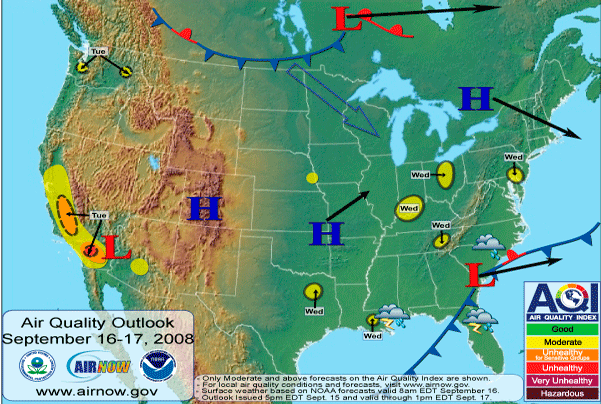| A cross-agency U.S. Government Web site. List of AIRNow partner agencies |

|
National Overview
Partners
Air Quality Basics
The AQI for...
Key Topics:
Resources |
| Contact Us |
| Privacy and Security Notice |
| Accessibility |
National Outlook for September 16-17
| Unhealthy AQI Levels in California | |
Tuesday, September 16 – Wednesday, September 17: In the West, sunny skies and warm temperatures will enhance ozone formation. As a result, parts of central and southern California will reach Unhealthy for Sensitive Groups AQI levels, with a few areas reaching Unhealthy AQI levels. Farther north, light winds will limit pollutant dispersion in the Northwest, resulting in areas of Moderate AQI levels in Washington. In the Southwest, gusty winds will cause blowing dust and result in Moderate AQI levels in Arizona. In the Midwest and East, a surface high pressure will produce light winds, liming pollutant dispersion. In addition, sunny skies and warm temperatures will enhance ozone formation. As a result, a few areas throughout the Midwest and East will reach Moderate AQI levels on Wednesday. Today's Forecast | Cities with Action Days (Air Quality Alerts) |
|
 |
|
| Health Tip: | Cut back on strenuous outdoor exercise when air quality is expected to be unhealthy. Exercise during the early morning or late evening hours when ozone levels are at the lowest levels of the day. This is especially important for children and other sensitive groups. The booklet, Air Quality Index - A Guide to Air Quality and Your Health, contains information about the health effects of the five most common air pollutants, and how to avoid those effects. |
| How You Can Help: | Reduce or eliminate fireplace and wood stove use when particle pollution levels are expected to be high. Reduce vehicle use. |
| Source: | U.S. Environmental Protection Agency |
| |
||||||||||||
|
AIRNow is a government-backed program. Through AIRNow, EPA, NOAA, NPS, news media, tribal, state,
and local agencies work together to report conditions for ozone and particle pollution.
State, Local and Tribal Partners.
|
||||||||||||
|
||||||||||||





